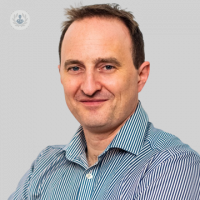Get your full range of movement back with TMJ surgery
Escrito por:The TMJ, or temporomandibular joint, connects your jawbone to your skull, and is like a sliding hinge. Unfortunately, when a person has a TMJ disorder, the full range of movement in the jaw may be limited, leading to limitation of mouth opening and/or pain.
For a small number of patients, in order to regain full (and painless) use of their TMJ, surgery may be required. Here to offer an expert guide to what’s involved, is highly regarded and skilled consultant oral and maxillofacial surgeon Mr Ross Elledge.

What is TMJ surgery, and how is it performed?
- Minimally invasive surgery
This includes arthroscopy and arthrocentesis. In arthroscopy, we put a small camera in the joint and examine it to enable minimally invasive interventions. For the small group of patients who require operative intervention, the majority will fit into this category and will benefit from a simple washout (arthrocentesis) of the joint along with intra-articular injections such as steroids, or potentially more complex interventions under direct vision through the arthroscope.
- Open surgery
A few patients will need something called an open arthroplasty. That will actually be opening the joint, and might include anything from reshaping the articulating surfaces, to removing or repairing the articular disc (meniscus), to replacing the entire joint using a custom joint replacement manufactured for the patient.
When is TMJ surgery required, and what specific conditions does it treat?
The most common condition that requires operative intervention is internal joint derangement. This is when the cartilage disc within the joint is displaced, and that results in painful clicking or locking.
So, the most common intervention is washing out the joint to try and free up that disc to get the joint to move better and to reduce associated pain. This procedure can also be beneficial in established arthritic changes, either from inflammatory arthritis or “wear and tear” (osteo)arthritis.
There are cases of more advanced arthritis (and other less common pathologies) that are either not appropriate for, or do not respond to, minimally invasive treatments. These are the cases that will require open surgery, including total joint replacement.
What are the main risks involved?
The main risk with an arthroscopy is a small chance of not entering the joint, meaning not being successful at a first attempt, although this is relatively uncommon. The other risks are damage to adjacent structures, so the ear canal, ear drum and skull base or airway. They are really rare complications; it's not uncommon for people to have a bit of temporary facial weakness, just for the few hours after the procedure. Theoretically it is possible to cause permanent facial weakness in an arthroscopy.
In a joint replacement (or any open surgery), the risks are much higher because it's much more complex surgery and probably the most important risks to be aware of are facial weakness which may be permanent, changes to way of biting (occlusion), hypersensitivity to the devices and eventual mechanical failure of the device, although this list is far from exhaustive. I only use Stryker/TMJ Concepts joint replacements that have published outcomes data of in excess of two decades in some units.
What can I expect during and after TMJ arthroscopy?
If you need an arthroscopy, then what you can expect first of all is that it is a relatively short procedure and I usually schedule about 30 to 40 minutes for one side and 60 minutes for both sides, to give myself enough time. Generally speaking, arthroscopy is day case surgery so you are in and out the same day. Occasionally patients will stay one night in hospital, just for pain control. Your joint may be a little swollen after the surgery and if you have any swelling after the surgery, that will take days to weeks to come down.
It may initially feel like it's a bit more painful but in the long run, the idea would be that the pain would settle down and improve, along with a functional improvement in movement of the joint. Recovery time is variable for arthroscopy, so if it's been very easy and straightforward people have very minimal pain and swelling. They feel pretty good within a couple of days.
Some people, where it's been really difficult or tricky, or in a small minority where it's been unsuccessful, may have some pain for a few weeks.
How long does joint replacement surgery take, and what does recovery time involve?
For a joint replacement, or open joint surgery, I usually schedule about three and a half hours for a unilateral replacement and six hours for bilateral surgery. It will take me the whole of the day to replace both joints when you factor in anaesthetic induction and recovery, and you would be my only patient that day.
Following an open arthroplasty or joint replacement, you should anticipate a couple of nights in hospital. There will be some drains left in following the surgery, which I will need to check the following day, and they will then need to be removed on the ward.
With open joint surgery, the most important thing is compliance with physiotherapy to get you working and mobilising the joint, and using it. That can be a little bit like the mantra of “no pain, no gain”. The more you comply with that physiotherapy, the better the outcome is.
For the open arthroplasty and joint replacements, I will see you initially at 7-10 days and then again at 6 weeks. I would say it’s at least at the 6-week review or longer when people start feeling any semblance of normality, or a better version of normality from having a joint replaced.
If you have a TMJ disorder and would like expert attention, arrange a consultation with Birmingham and Solihull-based oral and maxillofacial consultant Mr Ross Elledge via his Top Doctors profile.


